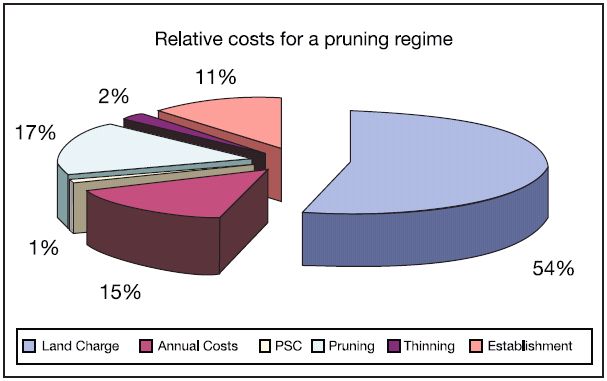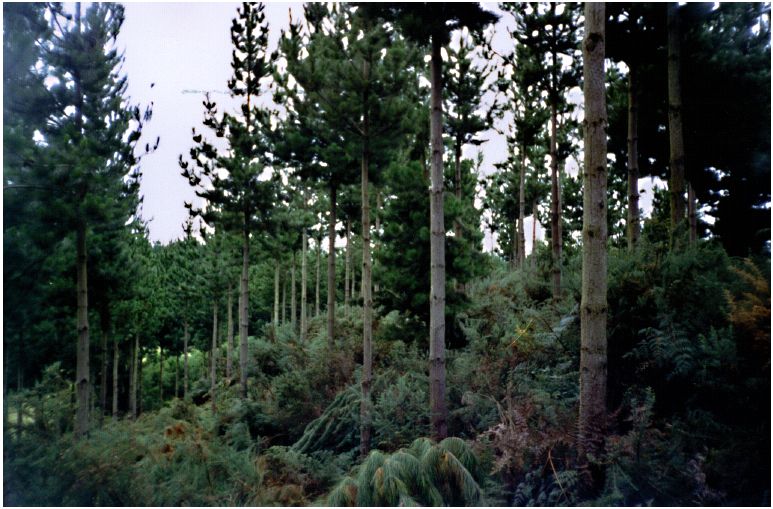Pruning and pruned stand certification
NZFFA Information leaflet No. 9 (2005).
New Zealand’s plantation resource is in the process of rapid change in size, quality and ownership. Prior to 1987, most of the high investment pruned plantations were owned by the state. The sale of this resource to large corporates is resulting in some dramatic changes. Through the 1990s, the forestry corporates have effectively ceased new planting and very recently severely reduced their collective spending on pruning. While this has taken place, there has been a major new entrant into the forest growing business with a totally different outlook on investment and returns.
This new party is the large body of investors and landowners attracted to high investment pruning regimes using radiata pine. Ownership is broadly based and many of the members are new to the business of forestry. Their debt is low and combined asset base is huge. Through the 1990s they have established in excess of a half million hectares on mostly ex-farm sites. At today’s log prices, this already existing estate will net the owners around 20 billion dollars at harvest and they are continuing their high level of investment in both new planting and pruning.
Forest management strategies
Two very different forest management strategies are currently in place. Although the forestry corporates are still undertaking major pruning investment, a large part of their collective estate will be managed on low cost non-pruning regimes.
There are two reasons for this. The first is the obvious short term benefit in reduced cost which appears to improve a company’s financial performance.
The second is that, so long as a forestry corporate has integrated processing capability, it has the option of ‘adding value’ through further processing at the end of the rotation. The payback on this additional expenditure is rapid unlike a pruning investment where the cost must be carried through the rotation.
By contrast, the new forest owners do not realistically have the option of ‘adding value’ at the end of the rotation via processing and then there are some compelling financial and risk aversion reasons that make pruning very good business.
Why prune?
Profitability. Using today’s costs and current log prices, it is a relatively simple task to show that a well pruned and appropriately marketed pruned stand is a highly profitable venture. On the other hand, it is very difficult to prescribe a non-pruning regime that doesn’t make a loss at realistic interest rates. However, the worst case scenario is having to carry the cost of a pruning regime that doesn’t achieve a high pruned log price either because the pruning was too late or it was badly marketed because the owner couldn’t prove it was well pruned.

Current log prices for the best pruned logs are up to $210/m3 (at mill or wharf) while unpruned log prices range around $60 to $100/m3 (at mill or wharf). A good pruning regime can produce logs worth $20,000 to $30,000 per hectare more than a regime without pruning. If we can prove the pruning was of a high standard, thereby eliminating much of the risk for the log buyer, the returns could be very much greater. Otherwise there will always be a margin for risk held back by the buyer if the buyer isn’t sure of how much value the pruning has added.
Market risk. An old and well-established axiom pervades most of our business – a quality product can be used in high or low value end-uses, a low value product has at best only low value end-uses. This has been brought home during the depressed log market following the Asian crisis. Knotty log grades were either not saleable or experienced major drops in price, yet pruned log demand has remained buoyant and prices are still high.

Many tropical and temperate countries have the land resource and conditions to grow huge amounts of industrial grade (unpruned) wood. If ‘carbon accreditation and trading’ becomes a reality, this could further fuel major new planting programs of ‘industrial’ plantations. Conversely, the world’s old natural forests, the major source of knot-free-timber, are becoming exhausted. The future principal supply of other than re-manufactured knot-free-timber must come from pruned forests. Few countries carry out extensive pruning (examples are; New Zealand, Chile, Australia to a lesser extent, and in Japan 10% of the cypress estate is pruned). In summary, for the private grower, there would appear little competitive advantage in growing unpruned plantations, but pruning produces a knot-free-timber for which there is strong demand, a diminishing supply and a wide range in end products.
Targeting quality. If you are growing radiata pine, there is one more very good reason to prune. Most growers are hoping to harvest on a rotation of around the 24 to 30 years. What will the wood be like? Unfortunately, the greater portion of the stem – the top half tapering into a core and extending down to the stump– will be wood largely suited to low-value end uses – packaging, low strength structural and pulp. It will be low in density, low in strength, have stability problems, low in surface hardness and inevitably very knotty.
The potentially higher value wood (suited to appearance and higher strength structural uses) is mostly confined to the outer wood of the butt log. This wood is higher density, stronger, more stable, has greater surface hardness and is even much more effectively preservative treated. Pruning is a large investment activity and this precious potentially high value wood is its sole target. Without pruning, it can only be at best knotty structural timber or suited to remanufacture.
Pruning produces knot-free-timber and means the outer wood’s inherent superior qualities can be realised. However, for the buyer it can be risky buying pruned logs. Logs of very different quality can look the same. If the pruning was late, the log may only have the same inherent value as a very branchy unpruned log. If the buyer can be assured of the effectiveness of pruning, the increased value resulting from pruning can be paid to the grower with much more confidence. To help this process occur, in 1991 the Forest Research Institute (FRI) introduced the Pruned Stand Certification service (PSC).
Pruned stand certification
PSC is a service that provides a facility to measure and credibly describe the effectiveness of pruning for price determination when the stand or pruned logs are sold. These objectives are achieved by the set of procedures that are the basis of PSC. These cover:
- A definition of work standards for quality of pruning to ensure a professional standard of pruning has taken place; plotting methodologies to determine essential stand parameters and measure how effective the pruning has been; and stand location and stand mapping to uniquely define and locate the stand.
- An audit process to give the pruning quality information credibility at both national and international levels. This process is undertaken by a nationwide network of registered auditors who either undertake or check all plotting and mapping work. An additional level of auditing implemented on a random basis by the administrator.
- An information archive which includes, audit details, all field measurements, stand maps, assessment plot locations and data summaries. All information is stored in a database supplemented with hardcopy and is retrievable.
- A unique certificate is provided for the stand owner showing important measures of stand quality and a location map supported by permanent comprehensive archived records.
Besides establishing the effectiveness of pruning, a PSC certificate also clearly proves the stand exists and has received a pruning operation of a professional standard. The plotting data also provide an excellent basis for accurate yield and log quality forecasts through the rotation. Another major benefit will result from the unity PSC gives this very large and valuable, but geographically dispersed pruned resource. Knowledge of location, stand age and size, and log yield and quality presents the opportunity to supply domestic and international markets of any size as part of an organised collective. Owners will benefit from the market ‘clout’ currently only enjoyed by the large forestry corporates.
What does PSC measure?
Besides the stand tenure information and a location map, the PSC certificate reports some simple stand parameters; stocking, the pruning lift height, the mean maximum diameter over pruned branch stubs (DOS), and a measure of precision. The stand data are obtained from sample trees. Where plot assessment work is already undertaken, this information is usually used if it meets the standards criteria. Measurement methods are described in the Pruned Stand Certification manual, FRI Bulletin 167.
Who is using PSC?
PSC has been operating since 1991 and usage is climbing steeply. Even without a further increase in rate of use, it is anticipated there will be between 350,000 and 500,000 hectares in the programme within a rotation of its initiation. This is a very substantial resource for which ownership, location, species, age, stand size, pruned log quality, general stand parameters, and likely yield by log quality/grade can all be readily established.
What is a typical stand profile under PSC?
Once again it is only possible to comment on the resource quantified within the PSC database. The users of PSC are almost invariably achieving high quality pruning operations. A typical stand profile would be:
- located on medium productivity ex-farm site,
- management advice and silviculture operations undertaken by a professional other than the owner,
- approximate area around 20ha,
- butt log pruned to around 5.5 to 6.5m in three lifts,
- DOS sizes (diameter over pruning stubs) well under 20cm for lower lifts and 18 to 20cm in the third lift, and
- final stocking around 300 to 400 stems/ha.
There is a substantial range in size of stands and more recently other species (particularly cypress) are also having their pruning certified. The new plantation resource of the private grower is large and much of it is being well managed under high investment pruning regimes (at least the stands in the PSC programme). Large areas will be available for harvest from 15 to 20 years and thereafter will be a main provider of New Zealand’s valuable pruned logs.
This resource is uncommitted and will increasingly become the focus of much national and international attention. The PSC programme provides an important mechanism to link this valuable and geographically dispersed resource. This linkage could provide major benefits for owners in marketing and coordinating harvest and log supply.
What does pruning cost?
For radiata pine, a pruning cost of around 50 cents/m of crown removed ($1/m for macrocarpa) is a useful guide. To put this in perspective, an example of the relative costs of all the main operations in growing a crop of trees over one rotation on an ex-pasture site using a discount rate of 8% can be found on page 9-2.
This article by Alan Somerville appeared in the November 1999 issue of the New Zealand Tree Grower.

 Farm Forestry New Zealand
Farm Forestry New Zealand